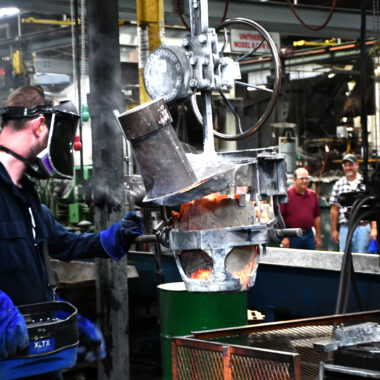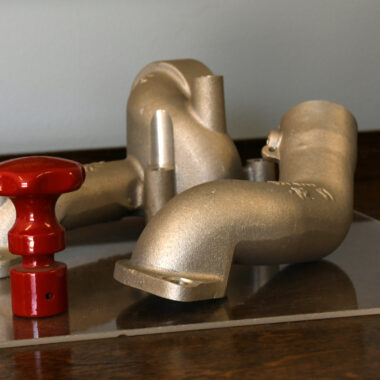Unraveling About Aluminum Casting: From Essentials to Expertise
Wiki Article
Unlocking the Potential of Light Weight Aluminum Casting: Proven Methods for Success
Light weight aluminum spreading has long been identified for its versatility and widespread applications across different sectors. Join us as we discover the crucial components that can push aluminum spreading towards unmatched success in today's competitive market landscape.Benefits of Light Weight Aluminum Spreading
One of the key benefits of aluminum spreading is its light-weight nature, which contributes to sustain performance in markets such as automotive and aerospace. In addition, light weight aluminum is extremely flexible, allowing for complex and detailed shapes to be easily produced via casting procedures.Furthermore, light weight aluminum spreading provides superb corrosion resistance, making it optimal for applications where exposure to severe atmospheres is a worry. The product additionally displays great thermal conductivity, which is advantageous for markets requiring warm dissipation, such as electronics (about aluminum casting). Furthermore, light weight aluminum is totally recyclable, lining up with the growing emphasis on sustainable techniques in modern-day manufacturing.
Design Considerations for Casting
When considering casting style, meticulous interest to detail is vital to guarantee the effective production of top notch components. The layout phase plays an essential function in the overall success of an aluminum spreading project. One crucial consideration is the choice of ideal geometries and features that assist in the spreading process. Designers have to consider aspects such as draft angles, fillets, and wall surface thickness to guarantee correct steel flow and solidification during spreading.Additionally, considerations associated to parting lines, gating systems, and risers are crucial to prevent problems like porosity and shrinking. It is vital to maximize the layout for efficient material usage and minimize post-processing requirements. Simulations and prototyping can be important tools in assessing and fine-tuning the casting style before full-blown production.
Cooperation in between layout makers, foundries, and engineers is vital to deal with any potential obstacles early in the layout phase. By incorporating these considerations into the casting layout process, suppliers can enhance item top quality, minimize costs, and ultimately open the full potential of light weight aluminum spreading.
Enhancing Casting Efficiency
When aiming to boost casting effectiveness in light weight aluminum casting jobs,Designing with a focus on maximizing material circulation and minimizing flaws is essential. To accomplish this, making use of simulation software application can aid in identifying prospective concerns before the spreading procedure begins. By mimicing the circulation of liquified aluminum, developers can readjust gating and riser designs to make sure correct filling and solidification, eventually minimizing the event of defects such as porosity or shrinking.
In addition, implementing appropriate warm therapy procedures can improve the total spreading efficiency. Heat treatment can assist boost the mechanical homes of the light weight aluminum spreading, making certain that the final component meets the needed specs. Furthermore, using automation and robotics in the spreading procedure can simplify manufacturing, reduce manual work, and rise general efficiency.
In addition, continuous surveillance and top quality control during the spreading procedure are critical for identifying any type of discrepancies and making certain that the end products satisfy the wanted standards. By implementing these strategies, manufacturers can enhance casting effectiveness, enhance item high quality, and eventually accomplish better success in aluminum casting projects.
Quality Assurance in Light Weight Aluminum Spreading

Effective top quality control practices play an essential role in making sure the accuracy and reliability of aluminum spreading procedures. Quality control steps in light weight aluminum casting include a series of tasks targeted at supporting details standards and identifying variances that can endanger the final product. These practices begin with the cautious option and examination of basic materials to guarantee their high quality and suitability for the spreading procedure. Tracking and regulating the criteria of the spreading procedure itself, such as cooling, pressure, and temperature rates, are essential steps in maintaining consistency and integrity in the end products.
In enhancement to process control, quality assurance in light weight aluminum spreading entails extensive screening and evaluation procedures at various stages of production. Non-destructive testing techniques like ultrasonic testing and X-ray assessment aid detect inner issues without jeopardizing the integrity of the actors elements. Visual examinations, dimensional dimensions, and mechanical testing better guarantee that the actors components meet the called for specifications and performance criteria. By carrying out robust top quality control practices, light weight aluminum casting centers can deliver items that meet consumer expectations for quality, efficiency, and integrity.
Optimizing Productivity
To accomplish optimal monetary efficiency, a detailed approach for optimizing productivity within light weight aluminum casting procedures should be thoroughly developed and performed. One key facet of optimizing profitability in aluminum casting is maximizing manufacturing efficiency.
Moreover, expanding item offerings and checking out new markets can help expand revenue streams. Understanding consumer demands and market fads can assist calculated decisions to profit from emerging possibilities. Buying r & you could try this out d to innovate processes or products can additionally drive earnings with differentiation and consumer contentment.
Final Thought
Finally, aluminum spreading uses various benefits in regards to design cost-effectiveness, toughness, and flexibility. By very carefully considering layout considerations, boosting casting effectiveness, implementing top quality control steps, and maximizing earnings, manufacturers can open the complete capacity of light weight aluminum casting. This flexible and reliable procedure has verified to be a successful option for a large range of commercial applications.In discover here addition, aluminum is extremely flexible, permitting for elaborate and complicated shapes to be conveniently generated through casting procedures.Reliable quality control practices play an essential duty in ensuring the precision and dependability of light weight aluminum spreading procedures.In addition to process control, quality control in aluminum casting includes strenuous screening and evaluation procedures at different phases of manufacturing. By applying durable high quality control techniques, light weight aluminum casting centers can deliver products that fulfill consumer assumptions for performance, dependability, and high quality.
By carefully considering layout considerations, enhancing casting effectiveness, carrying out quality control actions, and taking full advantage of profitability, suppliers can open the complete potential of light weight aluminum spreading.
Report this wiki page